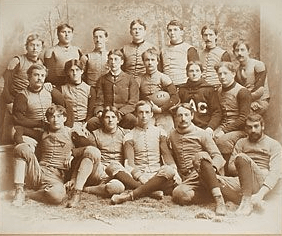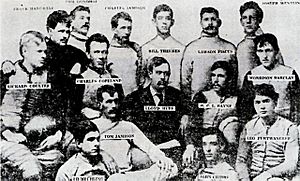Greensburg Athletic Association facts for kids
| Founded | 1890 |
|---|---|
| Folded | 1900 |
| Based in | Greensburg, Pennsylvania |
| League | Western Pennsylvania Circuit |
| Team history | Greensburg Athletic Association (1890-1900) |
| Team colors | Maroon, White |
| Nickname(s) | "Greenies" |
| Head coaches | Charlie Atherton (1894–1895) Alfred Sigman (1896) George Barclay (1897–1899) Ralph Hutchinson (1900) |
| General managers | Lloyd B. Huff |
| Owner(s) | Greensburg Athletic Association |
| W. Pennsylvania Championship wins | 1 (1897) |
| Home field(s) | Athletic Park |
The Greensburg Athletic Association was one of the first organized football teams. They were based in Greensburg, Pennsylvania. The team played in a professional football league in Western Pennsylvania from 1890 to 1900. Sometimes, people called them the Greensburg Athletic Club.
The team started as an amateur club in 1890. Most of the players were local people. But by 1895, they started adding professional players. In 1894, it was found that the team had secretly paid Lawson Fiscus, a player from Indiana Normal (now Indiana University of Pennsylvania). He was one of the first players to be paid a salary in football. The Greensburg team was a big rival of another early professional football team, the Latrobe Athletic Association.
Besides Fiscus, the Greensburg Athletic Association had many top players of that time. These included Charlie Atherton, George Barclay, Ross Fiscus, Jack Gass, Arthur McFarland, Charles Rinehart, Isaac Seneca, and Adam Martin Wyant. Some of these players even changed the game of football. Charlie Atherton is known for inventing the place kick. George Barclay created the first-ever football helmet. Isaac Seneca was the first Native-American to be named an All-American. And Adam Martin Wyant was the first professional football player to become a United States Congressman.
The team played their home games at Athletic Park. This field was later renamed Offutt Field. It is still used today by Greensburg Salem High School for football games.
Contents
History of the Greensburg Athletic Association
Early Amateur Years (1890-1893)
The first few years of the Greensburg Athletic Association, from 1890 to 1893, were not very successful. The team had trouble finding local opponents to play against. Also, there were not many experienced local players at first. It's not even known if the team won any games before 1894.
The Greensburg Athletic Association played its first season in 1890. Their first game was a 6–6 tie against Indiana Normal. They lost their first home game to the Kiskiminetas Springs School, 34–4. In 1891, the team lost to two top football clubs from Pittsburgh: the Pittsburgh Athletic Club and the Allegheny Athletic Association. In 1892, they played only two known games, losing both.
By 1893, Greensburg started focusing more on its football program. However, the results for most games that season are unknown. The team did lose 10–0 to the Pittsburgh Athletic Club.
The Glory Years (1894-1897)
1894: First Paid Player
In 1894, Greensburg hired its first professional player, Lawson Fiscus. They paid him $20 per game plus his travel costs. Fiscus had played for Greensburg as an amateur in 1893. But now, other teams wanted to pay him as football started to become professional.
During the 1894 season, Greensburg started strong with a 5-0 record. They then lost 10-0 to the Altoona Athletic Club. A week later, a game against the Jeannette Athletic Club ended early. This was due to a disagreement about Lawson Fiscus's rough play.
Greensburg played a rematch against Altoona on Thanksgiving Day. This time, Greensburg won 6-4 in front of about 2,500 fans. Back then, a touchdown was worth four points, and an "extra point" was worth two. Greensburg finished the season with a great record of 6 wins, 1 loss, and 1 tie. This success made football much more popular in Western Pennsylvania. Fans started coming to games in large numbers. They even traveled by train to away games. Fiscus was the only paid player in 1894, but more pros joined the team in 1895.
1895: Rivalry and Challenges
Greensburg's 1895 season began and ended with games against their main rival, the Latrobe Athletic Association. Latrobe was from nearby Latrobe. The Latrobe team had a strong player named John Brallier. He was the first football player to openly admit he was paid. Greensburg won the first game 25–0.
However, problems came up when Lawson Fiscus and two former Penn State University players, Charlie Atherton (who was also the coach) and Ed Robison, were offered $125 a month to play for another team, the Duquesne Country and Athletic Club. The Greensburg community raised extra money to keep these players. All three stayed with Greensburg. The team started with a 6–0 record. They then tied the Pittsburgh Athletic Club 0–0.
The next week, Duquesne Country and Athletic Club beat Greensburg 14-0. This game was controversial. A local person with ties to Duquesne was the referee. The Greensburg Daily Tribune newspaper called it "bad officiating" and "thievery." Despite this, Greensburg finished their season with a 9-1-1 record. The final game against Latrobe has a disputed score. Some records say Greensburg won 4-0, while one newspaper said Latrobe won 4-0.
1896: Strong Performance
In 1896, Alfred Sigman from Lafayette College became the team's fullback and coach. Two more Fiscus brothers, Ross and Newill, joined the team. Greensburg started the season with 5 wins in a row. These wins included games against the Pittsburgh Athletic Club and Latrobe. Pittsburgh newspapers said Greensburg was the best team in Pennsylvania.
On October 17, Greensburg beat the Pittsburgh Athletic Club for the first time, winning 14-0 at home. Lawson Fiscus scored all three touchdowns. On October 31, Greensburg defeated Latrobe 10-4. People in the stands were betting on whether Latrobe would score. Latrobe's Doggie Trenchard scored a touchdown late in the game. A Latrobe newspaper joked that "Greensburg got the game and Latrobe got the cash."
Greensburg's hopes of winning a state championship ended when they lost to the Duquesne Country and Athletic Club 18-4 on November 14. This was followed by a 0-0 tie with the Pittsburgh Athletic Club. Greensburg then beat Latrobe 10-0 on Thanksgiving Day. They finished the season with 6 wins, 1 loss, and 1 tie.
1897: Championship Season
The 1897 season was the best year for professional football in Greensburg. The team had 27 players, including many new ones. One new player was George Barclay from Millville. He played halfback at Bucknell University and Lafayette University. Barclay brought several top players from Lafayette to Greensburg.
Greensburg had a great record of 10 wins and only 1 loss. Their only loss was 12–6 to Latrobe in their ninth game. However, Greensburg won the rematch against Latrobe 6–0 at the end of the season. Greensburg and Washington and Jefferson College had the best football records in Pennsylvania for 1897. Barclay was the only Greensburg player chosen for The Pittsburg Times' "All-Western Pennsylvania" team.
Decline of the Team (1898-1900)
1898: Player Changes
The 1898 season started with hope as former coach Charlie Atherton returned. However, some players from the 1897 team left for better offers elsewhere. It was hard to find new talent for Greensburg because it was a small city and money was limited. Still, in 1898, the team had Christy Mathewson. He later became a famous baseball player and is in the Baseball Hall of Fame. He played fullback for Greensburg.
Greensburg's first game that season was against their rivals, Latrobe. The field was so muddy that the game had to be stopped. Mud had to be removed from Latrobe's Ed Abbaticchio's face after he was buried in it during a play. Latrobe won the game 6-0. The 1898 season also included another loss to Latrobe. They also tied games against Duquesne Country and Athletic Club and the Pittsburgh Athletic Club. However, the team improved later in the season. In their final game, Greensburg beat Latrobe 6-0.
At the end of the season, Greensburg's Charles Rinehart and George Barclay played in the first professional football all-star game. This was against the Duquesne Country and Athletic Club on December 3, 1898. The all-star team was put together by Latrobe manager, Dave Berry. Duquesne won the game 16-0. For unknown reasons, Greensburg's leaders did not want their players to join this game.
1899: A Break in Play
After facing money problems and less interest, professional football in Greensburg and Latrobe took a break in 1899. There were attempts to restart a team with local players from 1898. They also tried to get some Latrobe players. But this plan did not work out. In 1899, most of Greensburg's top players were playing for rival teams in Pittsburgh or even further away in places like Newark, New Jersey. Because there were no Greensburg or Latrobe teams in 1899, the Pittsburgh football clubs mostly played against teams from eastern Pennsylvania.
1900: The Final Season
In 1900, professional football returned to Greensburg. A businessman named Morris L. Painter helped bring the team back. Many players were from colleges and universities in the East and Midwest. The top player for the 1900 season was Ralph Hutchinson from Princeton. He signed with Greensburg as a player-coach. Also, Isaac Seneca, a former All-American from the Carlisle Indian School, joined the team. Latrobe's team was also reorganized by their manager, Dave Berry. They planned a three-game series between Latrobe and Greensburg.
Greensburg started the season with 2 wins, 1 loss, and 1 tie. They then lost 6-5 to the Homestead Library & Athletic Club. This was a Pittsburgh-area team supported by the Carnegie Steel Company. Greensburg newspapers called it "the greatest contest ever witnessed on the Greensburg gridiron." The game featured a match-up between two star players: Homestead's Art Poe and Greensburg's Isaac Seneca. Greensburg newspapers said Seneca played better than Poe. However, the Greensburg team had several key players get injured during the game.
After this, Greensburg struggled. They lost at home to Latrobe a week later on October 27. This was Greensburg's third loss in a row. During the game, a fight between Seneca and Latrobe's quarterback, Kennedy, led to a riot between fans and players. The police had to plan for more security for the return game in Latrobe. On October 31, the Greensburg team, still hurt by injuries, lost their fourth game in a row, 24-0, to Duquesne Country and Athletic Club. Greensburg's last win came on November 5, a 22-0 victory over Altoona. However, they lost to Homestead again five days later.
The final professional football game for Greensburg was on November 17, in Latrobe. Latrobe won the game 11-0. They claimed the "Westmoreland County championship." By this time, the Greensburg team had serious money problems. Their next-to-last game was canceled because of bad weather. Even worse, Latrobe, who always brought large crowds to Greensburg games, pulled out of a planned Thanksgiving Day game. Latrobe paid a $400 fee to cancel and played against Duquesne instead. However, that game was also canceled due to extreme weather. Greensburg's final season record was 3 wins and 7 losses.
Legacy of the Greensburg Athletic Association
Many players from the 1895 Greensburg team were known to be paid. These included Lawson Fiscus, Adam Wyant (a guard-quarterback from Bucknell and the University of Chicago), and fullback Charles Atherton and halfback Fred Robison (both from Penn State). Adam Wyant's coach at Chicago, Amos Alonzo Stagg, called him "one of the best men that ever donned the canvas jacket" (which was part of the uniform back then). Wyant later became the principal of Greensburg schools. He then became a U.S. Congressman from the Greensburg area. He was the first U.S. Congressman to have played professional football. Charlie Atherton, who has a street and a building named after him, later became the president of Penn State University.



